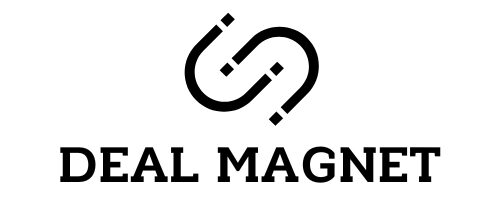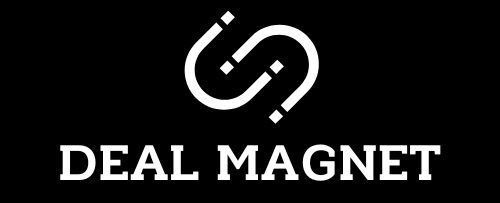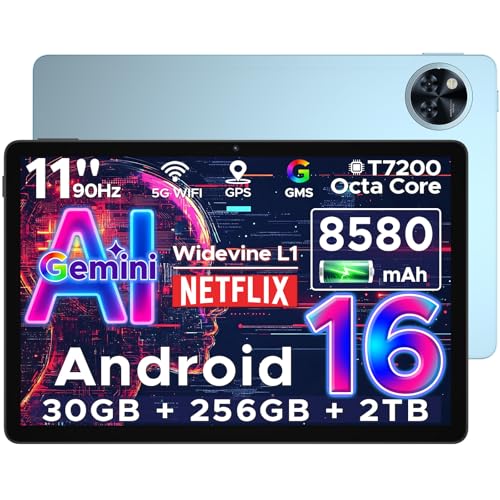“Dealmagnet.uk is a participant in the Amazon EU Associates Programme, an affiliate advertising programme designed to provide a means for sites to earn advertising fees by advertising and linking to Amazon.co.uk.”
Tablets have become a bridge between smartphones and laptops — offering the portability of a phone with the versatility of a computer. Whether you’re streaming videos, sketching artwork, reading eBooks, or managing business tasks, a smart tablet can adapt to your lifestyle.
But the market is crowded with models, sizes, and features that make choosing the right one overwhelming. Some tablets are built for entertainment, others for productivity, and some for creative professionals.
This buying guide will walk you through everything you need to know about tablets: key features, comparisons, pros and cons, use cases, and expert insights to help you find the perfect fit.
What to Consider Before Buying a Tablet
1. Screen Size & Resolution
- Small (7–8 inches): Ultra-portable, best for reading and casual browsing.
- Medium (9–11 inches): Balanced size, good for work and entertainment.
- Large (12+ inches): Great for productivity, design work, and multitasking.
Resolution is just as important as size:
- HD (1280×800): Sufficient for reading and basic tasks.
- Full HD (1920×1080): Crisp visuals, ideal for streaming.
- QHD/4K: Professional-grade clarity, useful for designers and video editors.
2. Performance (Processor & RAM)
- Entry-level tablets: Quad-core CPUs, 2–4GB RAM — good for browsing, eBooks.
- Mid-range tablets: Octa-core CPUs, 4–6GB RAM — smooth multitasking, gaming, and streaming.
- High-end tablets: Powerful processors, 8–16GB RAM — professional workloads, editing, 3D apps.
3. Storage & Expandability
- 32–64GB: Fine for casual users.
- 128GB–256GB: Best for media consumers and students.
- 512GB–1TB: Ideal for professionals storing large files, apps, and creative projects.
Look for expandable storage (microSD card slots) if you need flexibility.
4. Operating System
- Android: Wide range, customizable, many price points.
- iOS: Seamless ecosystem, excellent for productivity and creative apps.
- Windows tablets: Best for professionals needing desktop-level performance.
- Hybrid OS devices: Offer both laptop and tablet modes.
5. Battery Life
- Average range: 6–8 hours of screen time.
- Premium tablets: 10–14 hours, great for travel and workdays.
6. Connectivity
- Wi-Fi only: Affordable, good for home/office use.
- Wi-Fi + Cellular (4G/5G): Flexibility for on-the-go professionals.
- Ports: USB-C is standard; some tablets support external drives and accessories.
7. Accessories
- Stylus (pen): Ideal for artists, designers, and note-takers.
- Keyboard attachments: Turn tablets into mini-laptops.
- Protective covers & stands: For safety and comfort.
Product Summary by Category
| Tablet Type | Best Use Case | Key Features |
|---|---|---|
| Budget Tablets | Reading, light browsing | Compact, affordable, long battery |
| Mid-Range Tablets | Students, casual gamers | Good performance, decent display |
| Premium Tablets | Professionals, creators | High-resolution screen, fast CPU |
| 2-in-1 Hybrid Tablets | Productivity, business users | Detachable keyboards, stylus support |
| Kids’ Tablets | Education, safe content | Durable, parental controls |
| Entertainment Tablets | Streaming, gaming | Large display, strong audio |
Pros & Cons of Different Tablet Types
Budget Tablets
- Pros: Affordable, lightweight, great for reading.
- Cons: Limited storage, not powerful enough for multitasking.
Mid-Range Tablets
- Pros: Good balance of price and performance.
- Cons: Not ideal for heavy professional use.
Premium Tablets
- Pros: Excellent displays, powerful processors, professional-grade features.
- Cons: Expensive, accessories often sold separately.
2-in-1 Tablets
- Pros: Laptop-like productivity, versatility.
- Cons: Heavier, pricier than standard tablets.
Kids’ Tablets
- Pros: Durable, parental control features, preloaded content.
- Cons: Limited lifespan as child grows.
Entertainment Tablets
- Pros: Optimized for movies, games, and music.
- Cons: Not as good for professional productivity.
Who It’s Best For
- Students: Mid-range tablets with stylus support and decent storage.
- Business users: 2-in-1 tablets with detachable keyboards and productivity apps.
- Travelers: Lightweight, long-battery tablets with cellular connectivity.
- Gamers: High-performance tablets with strong GPUs and large displays.
- Artists & Designers: Premium tablets with stylus and high-resolution screens.
- Families: Affordable tablets with parental controls.
Tablet Comparisons by Purpose
| Purpose | Recommended Type | Why It Works Best |
|---|---|---|
| Reading & Browsing | Budget tablet | Lightweight, affordable, long battery life |
| Education/Study | Mid-range tablet | Performance for apps, stylus note-taking |
| Business & Work | 2-in-1 hybrid tablet | Keyboard, multitasking, desktop-like feel |
| Travel | Slim entertainment tab | Portable, battery-friendly, cellular option |
| Gaming | Premium performance | High RAM, GPU, and refresh rate |
| Creativity/Design | Stylus-support tablet | Pressure-sensitive pens, high-resolution |
Expert Insights & Real Experiences
- Portability is underestimated
A user who switched from a laptop to a lightweight tablet for daily commuting saved hours of back strain while still handling all work apps. - Stylus makes a difference
Many students report that writing with a digital pen improves retention compared to typing, making it a strong choice for note-takers. - Storage fills up quickly
Professionals in video editing often regret buying low-storage models — external drives help, but built-in storage saves time. - Hybrid vs. traditional tablets
Experts suggest hybrids if you’re replacing a laptop, but for casual streaming and browsing, they may be overkill.
FAQs About Tablets
Q: How long should a tablet last?
A: With proper care, most tablets last 4–6 years before performance noticeably slows.
Q: Can a tablet replace a laptop?
A: For basic work and study, yes. For heavy software (coding, video editing), laptops are still better.
Q: Is more RAM really important?
A: Yes — especially if you plan to multitask with multiple apps open.
Q: Do all tablets support stylus pens?
A: No. Check compatibility, as some require specific stylus models.
Q: Which tablet is best for kids?
A: Choose a durable one with parental controls, preferably with protective casing.
Final Recommendation
When buying a tablet, start by asking: What do I need it for?
- If it’s for reading, casual browsing, or streaming, a budget-friendly or mid-range option will serve you well.
- For students, go for mid-range tablets with stylus support and good note-taking apps.
- If you’re a business professional, a 2-in-1 hybrid tablet offers the best mix of portability and productivity.
- For creative professionals like designers and artists, invest in a premium tablet with a high-resolution display and advanced stylus.
- Families should consider durable kids’ tablets with safety features and parental control settings.
The key is balance — screen size, performance, storage, and budget all play roles. Choose a tablet that not only meets your needs today but also has the performance to keep up for years.
A smart tablet isn’t just a device; it’s a gateway to productivity, creativity, and entertainment. With the right choice, it can replace multiple gadgets in your life.
Latest Articles
- Smart Choices – The Ultimate Everyday Products Buying GuideALLWIN Disco Partylights – Music Control DJ Lights with Remote Control and USB, RGB Party Lights 60 Different Modes Karaoke Family Weddings Children’s Birthdays Kevsuvqin Card Shuffler Machine, 3000mAh Automatic Card Shuffler with USB Charging Cable, Two-deck Card Shuffling Machine, Low Noise Card Shufflers suitable for UNO, Poker, Texas Hold’em and blackjack USB Heated Gloves… Read more: Smart Choices – The Ultimate Everyday Products Buying Guide
- Clear Precision – The Ultimate Buying Guide for Glass ToolsZHJAN 2 Pack 8” Glass Suckers Lifters with Pressure Gauge,220kg Lift Capacity – Heavy Duty Vacuum Suction Cups with Carrying Case for Large Glass, Tile, Granite, Window Replacement “Dealmagnet.uk is a participant in the Amazon EU Associates Programme, an affiliate advertising programme designed to provide a means for sites to earn advertising fees by advertising… Read more: Clear Precision – The Ultimate Buying Guide for Glass Tools
- Spin in Style – The Ultimate Record Player Buying GuideHP-H2501 Retro Bluetooth Vinyl Record Player with Speakers, All-in-ONE Turntable with AT-3600L Cartridge, Belt Drive 2-Speed (33/45 RPM), Best for Music Lovers (HP-H2501) “Dealmagnet.uk is a participant in the Amazon EU Associates Programme, an affiliate advertising programme designed to provide a means for sites to earn advertising fees by advertising and linking to Amazon.co.uk.” In… Read more: Spin in Style – The Ultimate Record Player Buying Guide
- Breathe Easy: Your Complete Dehumidifier Buying GuideAROEVE Dehumidifier 1000ml, Dehumidifiers for Home, Auto Off, Auto Defrost, Peltier Technology, Coloured Light, Portable, Quiet, for Wardrobe, Bedroom, Bathroom “Dealmagnet.uk is a participant in the Amazon EU Associates Programme, an affiliate advertising programme designed to provide a means for sites to earn advertising fees by advertising and linking to Amazon.co.uk.” Humidity may be invisible,… Read more: Breathe Easy: Your Complete Dehumidifier Buying Guide
- Freedom to Clean: Your Ultimate Cordless Vacuum Buying GuideCordless Vacuum Cleaner,Stick Vacuum 45KPA/450W/60min,Wall-mounted Charging/V-shaped Anti-Tangle,with Self-standing Function and Removable Battery,Vacuum Cleaner for Pet Hair,Carpets and Hard Floors Ultenic T10 Lite Robot Vacuum Cleaner with Mop 5000Pa, 15min Lidar Quick Mapping, Self Charging & Emptying, Allergy Friendly, Carpet Auto-boost,Siri/Alexa/APP Remote Control Hoover for Floors Pet Hair Cordless Vacuum Cleaner 48KPa/550W/65min,Stick Vacuum Cleaner with Anti-Tangle… Read more: Freedom to Clean: Your Ultimate Cordless Vacuum Buying Guide
- Smart Choice: The Ultimate Smart Tablet Buying GuideDOOGEE 2025 Newest Android 15 Tablet, Tab E3 Pro 13 Inch Tablet, 32GB+256GB/2TB, Helio G100 Octa-Core Android Tablets, 11000mAh/18W, Large Tablets with SIM Card Slot, 3.5mm Jack/5G WiFi/8+13MP, Gray DOOGEE U11 Android 16 Tablets, Tablet 11 inch Android Tablets with 16GB RAM+128GB ROM+TF 2TB 8580mAh Battery, 90Hz IPS Screen, 13MP+5MP Camera,Wifi Gaming Tablet with Keyboard… Read more: Smart Choice: The Ultimate Smart Tablet Buying Guide
- Data on Demand: The Ultimate Hard Drive Buying Guide
 Aiolo Innovation 500GB Ultra Slim Portable External Hard Drive HDD-USB 3.0 for PC, Mac, Laptop, PS4, Xbox one,Xbox 363-Super Fast Transmission “Dealmagnet.uk is a participant in the Amazon EU Associates Programme, an affiliate advertising programme designed to provide a means for sites to earn advertising fees by advertising and linking to Amazon.co.uk.” In today’s digital… Read more: Data on Demand: The Ultimate Hard Drive Buying Guide
Aiolo Innovation 500GB Ultra Slim Portable External Hard Drive HDD-USB 3.0 for PC, Mac, Laptop, PS4, Xbox one,Xbox 363-Super Fast Transmission “Dealmagnet.uk is a participant in the Amazon EU Associates Programme, an affiliate advertising programme designed to provide a means for sites to earn advertising fees by advertising and linking to Amazon.co.uk.” In today’s digital… Read more: Data on Demand: The Ultimate Hard Drive Buying Guide - Power Up Smartly: Ultimate Charger & Battery Buying Guide
 Battery Charger Compatible with Dewalt 12V/20V Battery, 2-Ports Fast Charger Compatible with Dewalt DCB 203 204 205 206 201 120 127 Lithium Battery “Dealmagnet.uk is a participant in the Amazon EU Associates Programme, an affiliate advertising programme designed to provide a means for sites to earn advertising fees by advertising and linking to Amazon.co.uk.” From… Read more: Power Up Smartly: Ultimate Charger & Battery Buying Guide
Battery Charger Compatible with Dewalt 12V/20V Battery, 2-Ports Fast Charger Compatible with Dewalt DCB 203 204 205 206 201 120 127 Lithium Battery “Dealmagnet.uk is a participant in the Amazon EU Associates Programme, an affiliate advertising programme designed to provide a means for sites to earn advertising fees by advertising and linking to Amazon.co.uk.” From… Read more: Power Up Smartly: Ultimate Charger & Battery Buying Guide - Perfect Finish Every Time: Ultimate Paint Sprayer Buying Guide
 YIREAL Fence Paint Sprayer 800W,Electric Spray Paint Gun with 1300ml Container 3 Meters Cable 1.8M Hose,HVLP Spray Gun with 3 Nozzles 3 Spray Modes for Walls Ceilings Sheds Furniture House Painting “Dealmagnet.uk is a participant in the Amazon EU Associates Programme, an affiliate advertising programme designed to provide a means for sites to earn advertising… Read more: Perfect Finish Every Time: Ultimate Paint Sprayer Buying Guide
YIREAL Fence Paint Sprayer 800W,Electric Spray Paint Gun with 1300ml Container 3 Meters Cable 1.8M Hose,HVLP Spray Gun with 3 Nozzles 3 Spray Modes for Walls Ceilings Sheds Furniture House Painting “Dealmagnet.uk is a participant in the Amazon EU Associates Programme, an affiliate advertising programme designed to provide a means for sites to earn advertising… Read more: Perfect Finish Every Time: Ultimate Paint Sprayer Buying Guide - Sound Without Strings: Buying Guide for Wireless Earbuds & Earphones
 Niderson Wireless Earbuds, Headphones with Screen Stereo Bass, 48Hrs Playtime, Red Niderson Wireless Earbuds, Headphones with Screen Stereo Bass, 48Hrs Playtime, Grey Niderson Open Ear Wireless Earbuds Bluetooth Headphones, Grey Ear Buds for Fitness/Workouts/Travel “Dealmagnet.uk is a participant in the Amazon EU Associates Programme, an affiliate advertising programme designed to provide a means for sites… Read more: Sound Without Strings: Buying Guide for Wireless Earbuds & Earphones
Niderson Wireless Earbuds, Headphones with Screen Stereo Bass, 48Hrs Playtime, Red Niderson Wireless Earbuds, Headphones with Screen Stereo Bass, 48Hrs Playtime, Grey Niderson Open Ear Wireless Earbuds Bluetooth Headphones, Grey Ear Buds for Fitness/Workouts/Travel “Dealmagnet.uk is a participant in the Amazon EU Associates Programme, an affiliate advertising programme designed to provide a means for sites… Read more: Sound Without Strings: Buying Guide for Wireless Earbuds & Earphones - Smart Connections:Buying Guide for Adapters & Extensions
 AUNNO Double Shaver Plug Adaptor UK, 2500W 2 Way Plug Adapter for Bathroom Electric Razor and Electric Toothbrush etc, 2 Pin to 3 Pin Plug Adapter with 10A Fuse AUNNO Pack of 2 UK to European Plug Adapter, UK 3 Pin to European 2 Pin Plug Converter, Euro Type C, E, F and Type G,… Read more: Smart Connections:Buying Guide for Adapters & Extensions
AUNNO Double Shaver Plug Adaptor UK, 2500W 2 Way Plug Adapter for Bathroom Electric Razor and Electric Toothbrush etc, 2 Pin to 3 Pin Plug Adapter with 10A Fuse AUNNO Pack of 2 UK to European Plug Adapter, UK 3 Pin to European 2 Pin Plug Converter, Euro Type C, E, F and Type G,… Read more: Smart Connections:Buying Guide for Adapters & Extensions - Clean Smarter: The Ultimate Vacuum Cleaner Buying Guide
 Ultenic U15 Cordless Vacuum Cleaner 50000Pa/65Min Runtime, Anti-tangle Brush with GreenEye Technology, Self Standing Stick Vacuum, Telescopic Tube, Ideal for All Floors, Carpet & Pet Hair “Dealmagnet.uk is a participant in the Amazon EU Associates Programme, an affiliate advertising programme designed to provide a means for sites to earn advertising fees by advertising and linking… Read more: Clean Smarter: The Ultimate Vacuum Cleaner Buying Guide
Ultenic U15 Cordless Vacuum Cleaner 50000Pa/65Min Runtime, Anti-tangle Brush with GreenEye Technology, Self Standing Stick Vacuum, Telescopic Tube, Ideal for All Floors, Carpet & Pet Hair “Dealmagnet.uk is a participant in the Amazon EU Associates Programme, an affiliate advertising programme designed to provide a means for sites to earn advertising fees by advertising and linking… Read more: Clean Smarter: The Ultimate Vacuum Cleaner Buying Guide - Smart Picks: The Ultimate Smartphone Buying Guide
 DOOGEE Note 56 Mobile Phones, Newest Android 16 Smartphone, 6150mAh, 8.45mm Ultra-Slim, 6.56″ HD+ 90Hz, 24GB + 64GB/2TB Android Phones, Dual SIM Unlocked Mobile Phone, Face ID, GPS, OTG, FM-White DOOGEE Fier 5 Pro Android 15 Rugged Smartphone & Gemini AI – 20GB + 128GB, 13000mAh & MTK Helio G81 Octa Core Rugged Phone,90Hz 6.6″… Read more: Smart Picks: The Ultimate Smartphone Buying Guide
DOOGEE Note 56 Mobile Phones, Newest Android 16 Smartphone, 6150mAh, 8.45mm Ultra-Slim, 6.56″ HD+ 90Hz, 24GB + 64GB/2TB Android Phones, Dual SIM Unlocked Mobile Phone, Face ID, GPS, OTG, FM-White DOOGEE Fier 5 Pro Android 15 Rugged Smartphone & Gemini AI – 20GB + 128GB, 13000mAh & MTK Helio G81 Octa Core Rugged Phone,90Hz 6.6″… Read more: Smart Picks: The Ultimate Smartphone Buying Guide - Brew It Right: Your Coffee Buying Guide
 KOFIKOFI 54mm Bottomless Portafilter, Walnut Handle 3 Ears Naked Portafilter with Puck Screen, Compatible with Sage Breville Barista Series 500-880, Barista Express, and More 54mm Models KOFIKOFI Portafilter 58mm 2 Ears, Compatible with Gaggia Classic Espresso Machines, Naked Bottomless Portafilter with Puck Screen and Filter Basket (Black) KOFIKOFI Bottomless Portafilter 58mm with Puck Screen and… Read more: Brew It Right: Your Coffee Buying Guide
KOFIKOFI 54mm Bottomless Portafilter, Walnut Handle 3 Ears Naked Portafilter with Puck Screen, Compatible with Sage Breville Barista Series 500-880, Barista Express, and More 54mm Models KOFIKOFI Portafilter 58mm 2 Ears, Compatible with Gaggia Classic Espresso Machines, Naked Bottomless Portafilter with Puck Screen and Filter Basket (Black) KOFIKOFI Bottomless Portafilter 58mm with Puck Screen and… Read more: Brew It Right: Your Coffee Buying Guide - Clean Smarter, Not Harder: The Ultimate Vacuum Cleaner Buying Guide
 Ultenic U20 Cordless Vacuum Cleaner 55KPa/60Min,Enhanced Powerful Suction, Upgraded Anti Hair Wrap Brush with Fordable Wand, LED Countdown Display, Self Standing Hoover for Floors, Carpet & Pet Hair “Dealmagnet.uk is a participant in the Amazon EU Associates Programme, an affiliate advertising programme designed to provide a means for sites to earn advertising fees by advertising… Read more: Clean Smarter, Not Harder: The Ultimate Vacuum Cleaner Buying Guide
Ultenic U20 Cordless Vacuum Cleaner 55KPa/60Min,Enhanced Powerful Suction, Upgraded Anti Hair Wrap Brush with Fordable Wand, LED Countdown Display, Self Standing Hoover for Floors, Carpet & Pet Hair “Dealmagnet.uk is a participant in the Amazon EU Associates Programme, an affiliate advertising programme designed to provide a means for sites to earn advertising fees by advertising… Read more: Clean Smarter, Not Harder: The Ultimate Vacuum Cleaner Buying Guide




